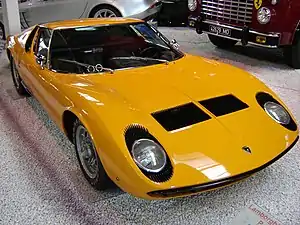Marcello Gandini
Marcello Gandini (born 26 August 1938) is an Italian car designer, known for his work with the automotive design house Gruppo Bertone, including his designs of the Lamborghini Miura, Countach, and the Lamborghini Diablo.[1]
Marcello Gandini (at right) | |
|---|---|
 Gandini (right) designed many world famous cars at the studio of Nuccio Bertone (left, 1976) | |
| Born | 26 August 1938 Turin, Italy |
| Nationality | Italian |
| Occupation | Automobile designer |
| Known for | Lamborghini Countach |
In a 2009 interview with Robert Cumberford, editor at Automobile Magazine, Gandini indicated, "his design interests are focused on vehicle architecture, construction, assembly, and mechanisms – not appearance".[1]
Life and career
The son of an orchestral conductor, Gandini was born in Turin.
In 1963, he approached Nuccio Bertone, head of the Gruppo Bertone company, for work. However, Giorgetto Giugiaro, then Bertone's chief designer, opposed him being hired.[1] When Giugiaro left Bertone two years later, Gandini was hired, and worked for the company for fourteen years.
Gandini created the 'Stile Bertone' styling house in Caprie – working both as its general manager, as well as designing concept cars, and managing the construction of prototype automobiles for many car makers that hired Bertone, and often Gandini in particular.[1]
Gandini became famous through his designs for many Lamborghini sports cars, beginning with the groundbreaking rear mid-engined Lamborghini Miura, with a transversely mounted V12, in the mid 1960s – a car often cited as one of the most beautiful sportscars ever – followed by the highly futuristic Marzal concept, the exceptionally low-built full-fledged four-seater Espada, and the spectacular Lamborghini Countach in the early 1970s.[2]
When Gandini applied the rear mid-engined layout even to the very rakish 2 + 2-seater Lamborghini Urraco, Ferrari hired him to design a very similar car for them as the second generation Dino, the Dino 308/GT4 – later rebranded as Ferrari's first V8-engined car, it became the only Bertone (Gandini) designed Ferrari, ever taken into production.
But Gandini also designed practical mass-production cars, even sub-compacts, such as the Innocenti Mini, the first generation Volkswagen Polo,[3] Gandini also styled the first-generation BMW 5 Series, the Citroën BX, and the 2nd gen Renault 5 (the 'Supercinq').[1]
Gandini introduced the concept of scissor doors on the Alfa Romeo 33 Carabo concept, and since their adoption in his Lamborghini Countach and Diablo, they became a staple of Lamborghini's V12 top models – to the point that these became synonymous as 'Lamborghini doors'. A signature feature, seen in a number of Gandini's designs, are unusual and strikingly shaped, forward and upward slanted rear wheel openings.
The Lancia Stratos rally sportscar, featuring an exceptional, seamless semi-elliptic windshield and door glass combination, is also a Gandini design.[1]
Gandini left Bertone in 1980, pursuing freelance automotive, industrial, and interior design.[1]
Gandini has worked in other areas, including home architecture, the design of a nightclub interior, and the body styling of the Heli-Sport CH-7 helicopter.[1]
Designs
Gandini car designs include:
- Alfa Romeo Montreal concept and production version
- Alfa Romeo 33 Carabo[4]
- Alfa Romeo Navajo
- Audi 50[5]
- Autobianchi A112
- Autobianchi A112 Runabout
- Bertone Pirana
- Bugatti EB 110 (prototypes)
- BMW 5 Series (E12), including the concept Garmisch in 1970
- Citroën BX
- Citroën GS Camargue
- Cizeta-Moroder V16T
- De Tomaso Biguà (Qvale Mangusta)
- De Tomaso Pantera SI
- De Tomaso Pantera 'Prossima Generazione'
- Dino/Ferrari 308 GT4
- Ferrari Rainbow
- Fiat 132
- Fiat X1/9
- Iso Lele
- Iso Grifo 90
- Iso Grifo 96
- Jaguar Ascot
- Lamborghini Bravo
- Lamborghini Countach[4]
- Lamborghini P140
- Lamborghini Diablo (prototypes)
- Lamborghini P147 Acosta
- Lamborghini Espada
- Lamborghini Jarama
- Lamborghini Miura
- Lamborghini Urraco
- Lamborghini Marzal
- Lancia Stratos Zero
- Lancia Stratos[4]
- Lancia Sibilo[6]
- Maserati Khamsin
- Maserati Ghibli II
- Maserati Quattroporte II (1974–1978) & IV (1994–2001)
- Maserati Shamal
- Maserati Chubasco
- 1st and 2nd Maserati Biturbos facelift
- Nissan AP-X
- NSU Trapeze
- Perodua Kancil (facelift)[7]
- Renault 5 Turbo
- Renault 5 Supercinq
- Renault Magnum
- TaMo Racemo
- Stola S81 Stratos[8]
- Stola S86 Diamante
- Volkswagen Polo Mk1[5]
- Volvo Tundra
Gallery
.jpg.webp) 1968 Alfa Romeo Carabo concept
1968 Alfa Romeo Carabo concept 1968 Lamborghini Miura S
1968 Lamborghini Miura S 1970 BMW 2002ti Garmisch concept
1970 BMW 2002ti Garmisch concept.jpg.webp) 1970 Lancia Stratos Zero concept
1970 Lancia Stratos Zero concept 1972 BMW 5 Series (1st generation)
1972 BMW 5 Series (1st generation).jpg.webp) 1973 Lancia Stratos
1973 Lancia Stratos
 1974 Maserati Khamsin
1974 Maserati Khamsin.jpg.webp) 1976 Ferrari Rainbow concept at left, and 1973 Ferrari GT4 at right
1976 Ferrari Rainbow concept at left, and 1973 Ferrari GT4 at right 1982 Citroën BX Hatchback became one of the best-selling Citroën models
1982 Citroën BX Hatchback became one of the best-selling Citroën models
.jpg.webp) 1990 Maserati Shamal
1990 Maserati Shamal.jpg.webp) 2000 Stola S81 Stratos concept
2000 Stola S81 Stratos concept
References
- "Marcello Gandini – Automotive Designer". Automobile Magazine, Robert Cumberford, October 2009.
- Banks, Nargess (2021-06-14). "Livro revela os carros preferidos dos colecionadores: Ferraris, Bugattis e Lamborghinis raros e exóticos estão na lista". Forbes Brasil. Retrieved 2021-06-14.
- Initially launched as the Audi 50, but then repositioned as Volkswagen's entry-level car, even below the Giugiaro styled, subcompact first generation VW Golf.
- "The Stars & Cars of Bertone". Road & Track: 78. November 2014.
- Finalised by Claus Luthe
- The Lancia Sibilo Was Nuts Even By 1970s Concept Car Standards – Jalopnik
- "Perodua Kancil by Marcello Gandini". carrozzieri-italiani.com. Retrieved 15 September 2022.
- "Stratos S81". blutecsrl.it. Retrieved 19 July 2019.
External links
| External image | |
|---|---|
- Fiat X1/9 web site
- BMW Designers Marcello Gandini on the page with an overview of automotive designers working for BMW.
- Marcello Gandini: Maestro of Design by Gautam Sen. A complete two volume set featuring the designs and biography of Marcello Gandini.